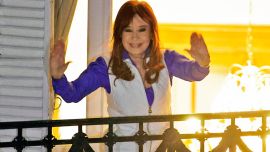In Argentina, where about a dozen different exchange rates overlap, the government is creating ever more rules about who can access dollars and for what, making an already vexing system more complicated in a bid to delay a devaluation.
Government officials on Wednesday will roll out new taxes applied to the official exchange rate for foreign travel ahead of the World Cup in Qatar next month and for locals attending concerts by artists such as British rock band Coldplay. The latest iterations come on top of recent currency rules and specific rates for the tech sector and grain exporters, piling on an alphabet soup of existing parallel exchange rates.
The official rate is 150.7 pesos per dollar while the black market trades at about 280 pesos on the streets of Buenos Aires.
Unlike most of its Group of 20 peers, Argentina doesn’t have a free-floating currency. President Alberto Fernández’s government controls the peso’s minimal daily decline through a cobweb of currency controls, price freezes and import restrictions with the goal of protecting dwindling dollar reserves.
The strategy is in direct clash with the International Monetary Fund’s currency policy recommendations, requiring a formal waiver during the most recent review of the country’s US$44-billion programme, the largest for the Washington lender.
“Exchange restrictions and multiple currency practices should be unwound as conditions permit and reserve coverage strengthens,” IMF Managing Director Kristalina Georgieva said in a statement on Argentina last week, noting such policies “are not a substitute for sound macroeconomic policy.”
Multiple rates
Although alternative exchange rates are not new to Argentina, they’ve thrived over the past three years under Fernández, including a commonly use rate in markets and another for credit cards also trading above the official peso. The most used of these, know by Argentines as the “dollar blue,” is a free-floating, all-cash exchange rate.
It’s all a consequence of Fernández’s efforts to avoid an sudden currency devaluation seen as destabilising for the market and consumers, who are already grappling with inflation estimated to end the year at 100 percent.
Heading into next year’s presidential election, leaders in his ruling Frente de Todos coalition consider a devaluation as politically damaging for the impact that it will have on inflation and wages, according to senior lawmakers who asked not to be identified speaking about the strategy.
While the restrictions have helped to contain some of the haemorrhage of reserves, at the same time it created an increasingly bureaucratic system where companies and consumers face high transactional costs and foreign investment has little incentive to bring dollars into the country.
And by keeping the value of the peso artificially high, exporters who are forced to sell at that rate lose money -- hence the government’s renewed push to give them special conditions -- while savers increasingly demand more cheap dollars to protect against accelerating inflation.
The government measures “are band-aids that create distortions,” Maria Castiglioni, director at consulting firm C&T Asesores in Buenos Aires, said. “This is a way of devaluing in steps: Raise taxes on tourism abroad to contain the flight of dollars.”
Here’s a look at some of Argentina’s exchange rates:
The official rate
Rate: 150 pesos per dollar
Argentina’s official exchange rate is highly restricted. Individuals can only legally exchange pesos at a bank on the official rate for no more than US$200 a month and must pay two taxes that add roughly 75 percent to the cost.
The “blue”
Rate: 280 per dollar
The most-commonly accessed rate among Argentines, the “dolár blue” is a free-floating, all-cash exchange rate found on the streets of Buenos Aires even if it’s technically illegal.
The market rates
Blue-chip rate: 306 per dollar
Argentina also has free-floating exchange rates for investors who buy stocks and bonds. For local transactions, an exchange rate known as “dolár MEP” is used, while the blue-chip swap rate, or “dolár CCL,” is utilised for operations that finish abroad.
Credit card
Rate: 275 per dollar
For monthly purchases under US$300 a month, an implied exchange rate combining Argentina’s official rate with the two taxes charged on credit cards for purchases in foreign currency besides pesos.
Qatar Dollar
Rate: 300 per dollar
For monthly purchases over US$300 a month, an implied exchange rate combining the official rate with the two existing taxes and new, third levy of 25 percent. The implied rate starts Wednesday and is being associated with thousands of Argentines travelling to Qatar for the World Cup, the world’s most important sports event.
Coldplay Dollar
Rate: 195 per dollar
Argentines attending concerts by artists who charge in foreign currency will pay a 30 percent tax on top of the cost of the ticket. It’s informally named after the British rock band, which is playing 10 sold out shows in Buenos Aires this month.
Soy Dollar
Rate: 200 per dollar
The soy dollar, a government-designed fixed exchange rate, lasted for about three weeks in September, carrying short-term export gains with some long-term concerns of higher inflation caused by a ballooning amount of money circulating in the economy.
Tech Incentives
Tech companies can retain 30 percent of the dollars from additional sales abroad instead of having to exchange them into pesos, as the law stood before. The dollars are meant for employees’ salaries.
related news
by Patrick Gillespie, Bloomberg





















Comments